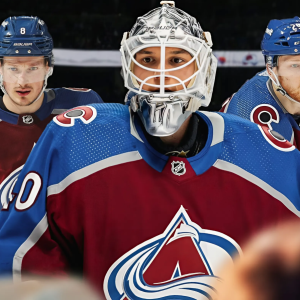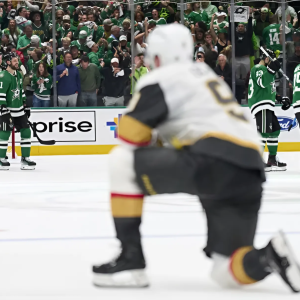We’re still two and a half months away from the start of the 2024-25 regular season, so the time for hockey is coming but is still fairly distant. In the meantime, let’s look at some very early opening night lineup projections for the Philadelphia Flyers.

Here, I’ll be looking at the Flyers’ forward lines, their defense, and their goaltending. I’ll explain the rationale behind each pick and why it makes sense. What might head coach John Tortorella realistically roll with?
Flyers’ Forward Lines
Let’s start with the Flyers’ forward lines entering next season. Below is what I project:
| Left Wing | Center | Right Wing |
| Tyson Foerster | Sean Couturier | Matvei Michkov |
| Owen Tippett | Morgan Frost | Travis Konecny |
| Joel Farabee | Scott Laughton | Bobby Brink |
| Noah Cates | Ryan Poehling | Garnet Hathaway |
| Nicolas Deslauriers |
For this, I’ll work from the bottom to the top. Nicolas Deslauriers suited up more often than not last season (60 games played), but there doesn’t seem to be a path for him to make the opening night lineup. Even at the end of last season, he appeared in only one of the Flyers’ last 12 games—what does that say? If Tortorella wasn’t confident enough to use him when the games mattered more than ever, he probably won’t look his way this time barring an injury to someone else. It seems like he’ll be facing an uphill battle over the duration of 2024-25.
The Noah Cates, Ryan Poehling, and Garnet Hathaway trio were depended on heavily in the latter half of last season by Tortorella. They were getting as much as second-line minutes together, but they’d ideally be at the bottom of the lineup, playing more when the Flyers are trying to prevent goals and less when they’re trying to score. This is a low-event group but one that can come up clutch when asked. They look to be one of the best fourth lines in the NHL, holding a 71 expected goals percentage (xGF%) in 159 minutes of 5-on-5 play in 2023-24.
For our third line, Joel Farabee and Bobby Brink seem like a good fit. That’s where they slotted to start last season, and they developed a little bit of chemistry in the process. I have Scott Laughton centering them mainly because I believe in his potential to bounce back. His 2023-24 campaign was a rough one for him, but we have way more evidence to suggest that he is still a very capable third-line center versus what he showed in his most recent outing.
For this line to work, Laughton is the X-factor here. When Farabee and Brink were together and the veteran center was out of the equation, they held a very good 53.4 xGF% at 5-on-5 action over 238 minutes of ice time. If he can return to his old form, this third line could be a useful one.
There are a lot of avenues for the second line, but I chose to go with a trio that we saw be pretty successful toward the end of last season. Owen Tippett, Morgan Frost, and Travis Konecny held a 59.5 xGF% in 2023-24 with a plus-11 rating in 128 minutes at 5-on-5. Those results are pretty remarkable, so don’t be shocked if Tortorella tries that out again. This was a line that produced offense pretty consistently, which is exactly what a team that finished 27th in goals needed last season.
For our first line, I have Tyson Foerster, Sean Couturier, and the newcomer Matvei Michkov. It might be a bit ambitious to have a teenager like Michkov on the top line immediately, but I believe it makes the Flyers the best team possible.
Before we get into that, I want to argue against a point I have seen come up a few times. The general consensus is that Couturier doesn’t belong anywhere near a first line. While that might have been true at the end of last season, battling a sports hernia, it definitely wasn’t at the beginning when he was presumably healthier. Coming off a 22-month absence due to multiple back surgeries, he was actually as good as anyone could have ever imagined.
Included in a table are some advanced stats of the first 41 games of his 2023-24 season compared to his entire 2017-18 campaign when he was in his prime. For the stats in this comparison, I used the following: points per 60 (P/60), relative xGF% (xGF% Rel), relative Corsi percentage (CF% Rel), relative goals percentage (GF% Rel), and average time on ice (ATOI).
To put the numbers in better context, I compared where Couturier ranked among all forwards percentile-wise. Both last season and what some (myself included) consider his peak are closer than you might think:
| Stat (5-on-5) | Couturier’s First 41 Games in 2023-24 | Couturier’s Full 2017-18 Season | Percentile (All Forwards) |
| P/60 | 2.05 | 2.08 | 77th vs. 85th |
| xGF% Rel | 5.77 | 6.84 | 82nd vs. 91st |
| CF% Rel | 8.62 | 5.19 | 96th vs. 92nd |
| GF% Rel | 16.2 | 18.1 | 91st vs. 95th |
| ATOI | 14:15 | 15:06 | 91st vs. 97th |
While the 2023-24 section was only 55.4 percent of his actual season, there is clearly some good left in Couturier. In fact, it is directly comparable to his 2017-18 campaign. Even though he played 88.9 percent of his ice time at 5-on-5 with Claude Giroux that season, who scored 102 points, the results are still very similar. At full health (or relatively close to it), the 31-year-old center is capable of being on a first line. His durability is a legitimate concern, but his upside should not be.
Getting the Couturier tangent out of the way, he played some of his best minutes with Foerster. Sharing a 61.8 xGF% and a plus-3 rating in 347 minutes of ice time with one another, their results were terrific even when Couturier started his regression. What that duo really needed to be truly great was an offensive dynamo like Michkov. Well, now they’re in luck.
Both Couturier and Foerster were very good during in-zone sequences but didn’t have a superstar on their line to take advantage of that. Michkov might not be this kind of player immediately, but he has displayed the habits that imply he can be a dominant in-zone scorer. As a duo, Couturier and Foerster possessed the puck a lot but never really did anything with it—Michkov can change this. This has the potential to be an impressive line, but we won’t know for certain until we see the on-ice product.
Someone who just missed the cut for the lineup is Olle Lycksell. He got some looks with the Flyers at the end of the season, but I have him playing in the American Hockey League (AHL). Instead of being an extra forward—especially when Tortorella ran with seven defensemen per game on several occasions last season—he can play in the AHL and get top-line minutes instead. To me, that seems a lot more beneficial than the alternative of getting fourth-line playing time at the absolute best.
Flyers’ Defensive Lines
There’s much less creativity required for the defense, but there’s still a lot to talk about. Below are my pairings for 2024-25:
| Left Defense | Right Defense |
| Cam York | Travis Sanheim |
| Nick Seeler | Jamie Drysdale |
| Egor Zamula | Rasmus Ristolainen |
| Adam Ginning | Erik Johnson |
Once again, we’ll start from the bottom and end at the top. Erik Johnson is the obvious choice for the Flyers’ seventh defenseman—he’ll likely take on the Marc Staal role from last season and play sparingly but slot in here and there. It gets tricky after Johnson, but I chose Adam Ginning. I also considered Emil Andrae, but he’s in the AHL for the same reason as Lycksell—it seems more beneficial for him to get top-pairing minutes than battle for a lineup spot. Ginning would possibly be playing behind Andrae in the AHL anyway, so having him available for a rainy day seems logical enough.
For the third pairing, I have Egor Zamula and Rasmus Ristolainen. The former did not have the best 2023-24 campaign, but he is just 24 and got a $1.7 million average annual value (AAV) contract—the Flyers clearly like him. The two were just okay together with a 50.9 xGF% in 197 minutes at 5-on-5, but that’s not too bad for a third pairing. With his first full NHL season out of the way, Zamula should be more up to speed and that duo could be better if they are healthy.
I have talked about the Nick Seeler and Jamie Drysdale second pairing and the potential it has pretty extensively, but I’ll revisit it once more. Drysdale’s numbers were miserable with the Flyers, but that wasn’t the case in the 104 minutes of 5-on-5 ice time that he spent with Seeler. With a 52.4 xGF%, the duo had some good numbers even though the former was playing with a sports hernia through the entirety of his 2023-24 campaign. At full health, these two could be special.
The first pairing here needs no introduction. Cam York and Travis Sanheim played most of their 2023-24 seasons together with mixed results. They shared a 49.7 xGF% which isn’t terrible for a first pairing, but there’s definitely some room for growth. Seeing as York is still just 23, his improvement can help the duo put up more respectable numbers. They will probably play a lot together in 2024-25 unless one of them were to get hurt.
Flyers’ Goaltenders
Finally, we get to the goaltending. I’ll cover both the NHL and the AHL because both are relevant to the Flyers:
| NHL Goaltenders | AHL Goaltenders |
| Sam Ersson | Cal Petersen |
| Ivan Fedotov | Alexei Kolosov/Parker Gahagen |
I have covered Sam Ersson and Ivan Fedotov in some detail, so I’ll try to keep my thoughts short so as not to be redundant. Ersson had good to elite starter numbers until about the middle of the season—he was excellent when starting every other game. When his workload went from typical to Juuse Saros-caliber, his body just wasn’t able to keep up—a 24-year-old rookie like him couldn’t produce without rest. Fedotov, whether he lives up to his hype or not, is vital to have. As long as he’s getting starts and Ersson is getting rest, this duo can work in theory. If he’s actually good, they could be exceptional. The Flyers had the second-worst team save percentage (SV%) last season, but it’s not unrealistic to think they could be closer to the league average assuming they are healthy and their netminders live up to expectations.
If Fedotov struggles to the point where he is costing the Flyers games, that’s where there could be some issues. One AHL goaltender we know will be present is Cal Petersen—he was basically unusable at the NHL level. Alexei Kolosov could be a solid emergency option in Philadelphia, but it seems like he is going back overseas to play in the Kontinental Hockey League (KHL) in 2024-25—that’s bad news if any injuries occur. The Flyers could always trade for another goalie if things don’t go according to plan, but it’s not like there are a ton of good options. There are some question marks between the pipes, but there is undoubtedly potential.
Seeing as the Flyers finished with 87 points last season but missed the playoffs because of a dreadful stretch of just two wins in their final 11 games, this roster seems good enough to contend for a postseason spot. Without a berth in the playoffs since 2020, getting over the hump this time would mean a lot for hockey in Philadelphia.





